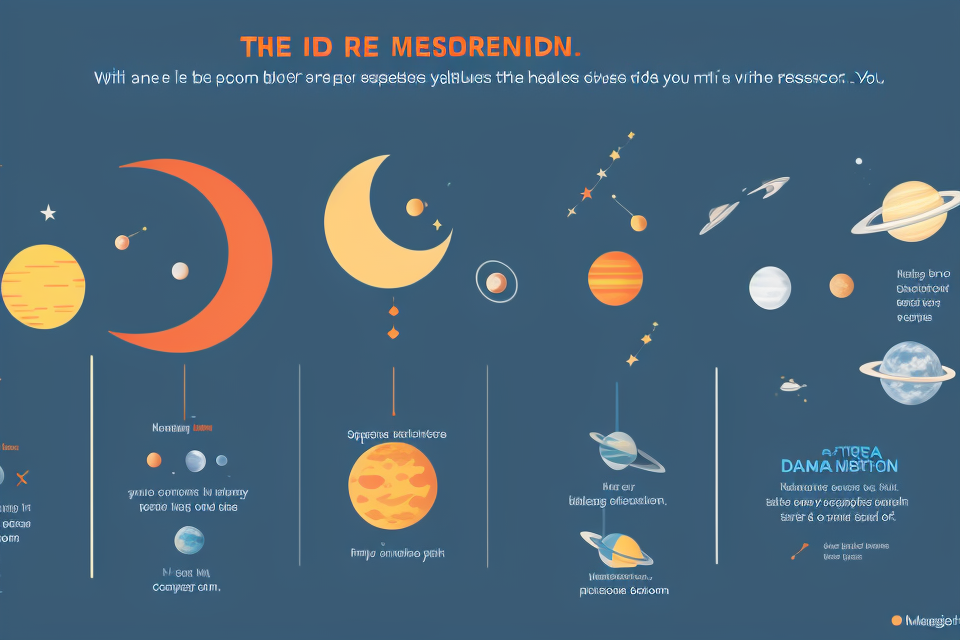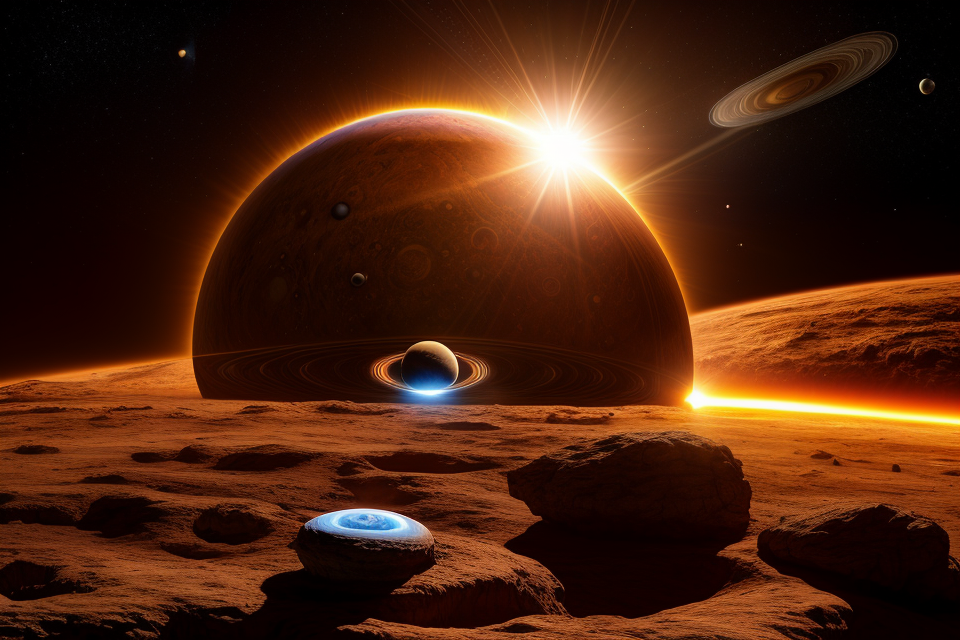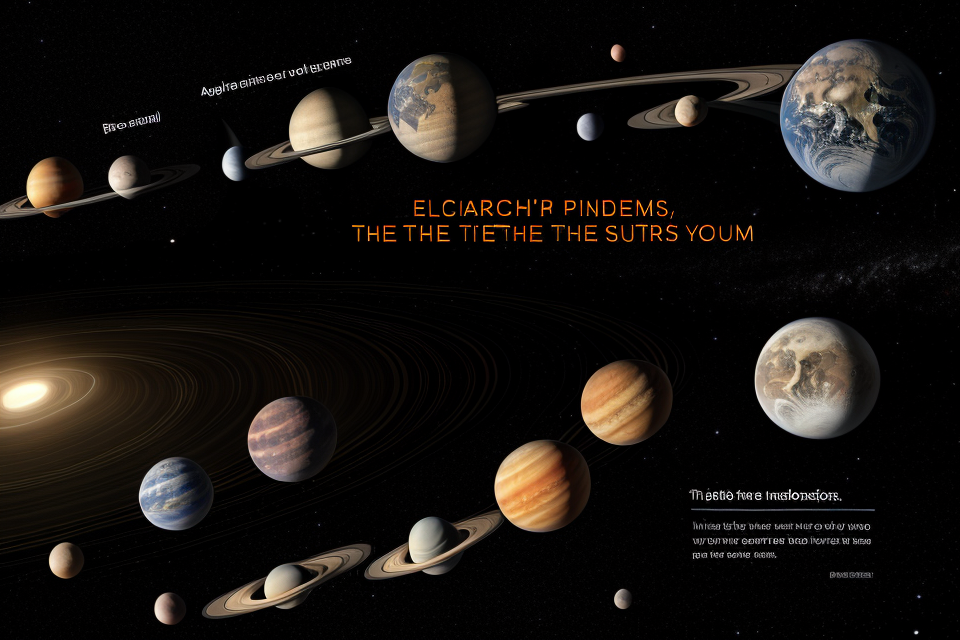Have you ever wondered about the nature of our solar system? Many people assume that the solar system revolves around the moon, but in reality, it’s the other way around. Our solar system is a vast and intricate network of celestial bodies, including planets, moons, asteroids, comets, and more. The sun is at the center of it all, providing light and heat to the planets, making life possible on Earth. In this article, we will explore the concept of the solar system and debunk common misconceptions about the sun and the moon. Get ready to expand your knowledge and understanding of our amazing universe!
The Sun: The Heart of Our Solar System
What is the Sun?
- The Sun is a star located at the center of the solar system.
- A star is a massive celestial body composed of hot gas that emits light and heat. The Sun is classified as a G-type main-sequence star, also known as a yellow dwarf star, and is composed primarily of hydrogen and helium gases.
- It is composed of hydrogen and helium gases.
- The Sun’s composition is approximately 74% hydrogen, 24% helium, and trace amounts of other elements. These gases are held together by their mutual gravitational attraction and undergo nuclear reactions in their cores to release a tremendous amount of energy in the form of light and heat.
- The Sun’s immense gravitational pull keeps the planets, including Earth, in orbit around it.
- The Sun’s gravity is what holds the solar system together and gives the planets their orbits. The gravitational force of the Sun is what keeps the planets, including Earth, in orbit around it. The mass of the Sun is about 93 million pounds, which is about 330,000 times the mass of the Earth. The Sun’s gravity is so strong that even the tiniest of objects, like a small asteroid, can feel its pull. The Sun’s gravity is what holds the solar system together and gives the planets their orbits.
The Sun’s Importance to Life on Earth
The Sun is an incredibly powerful and vital component of our solar system, and its importance to life on Earth cannot be overstated.
The Sun Provides Earth with Light and Heat
The Sun is the primary source of light and heat on Earth, making life possible on our planet. Without the Sun, the Earth would be a frozen, barren wasteland, incapable of supporting any form of life. The Sun’s energy drives the Earth’s climate, creating seasons, generating half of the oxygen we breathe, and providing warmth and sustenance to all living organisms.
The Sun’s Role in Photosynthesis
Photosynthesis is the process by which plants, algae, and some bacteria convert sunlight into energy. This process is essential to life on Earth, as it is the foundation of the food chain. The Sun’s energy is absorbed by plants, which then convert it into sugars and other organic compounds, providing energy and nutrients for all living organisms.
The Sun’s Magnetic Field Protects Earth from Harmful Radiation
The Sun’s magnetic field is a powerful force that helps protect Earth from harmful solar radiation. This magnetic field creates a barrier that shields the Earth from solar winds, which can cause damage to our atmosphere and disrupt our technology. The Sun’s magnetic field also helps to regulate the flow of charged particles from the Sun to the Earth, preventing them from colliding with our planet and causing damage.
In conclusion, the Sun is a vital component of our solar system, and its importance to life on Earth cannot be overstated. From providing light and heat to driving photosynthesis and protecting us from harmful radiation, the Sun is essential to the survival of all living organisms on our planet.
The Moon: Earth’s Celestial Companion
What is the Moon?
- The Moon is a celestial body that orbits the Earth, and it is the only natural satellite of our planet.
- It is about one-quarter the size of Earth and has a diameter of approximately 3,474 kilometers. This makes it the fifth largest moon in the solar system.
- The Moon is in synchronous rotation with Earth, meaning that it always shows the same face to us. This is known as the “near-side” of the Moon, and it is caused by the gravitational interaction between Earth and the Moon.
- The Moon is composed primarily of rock and iron, and it has a thin atmosphere composed of gases that are escaping from Earth’s atmosphere. This atmosphere is known as the “lunar atmosphere,” and it is much thinner than Earth’s atmosphere.
- The Moon has no moons of its own, but it does have many craters, valleys, and mountains. These features were formed by impacts from asteroids and comets over billions of years.
- The Moon also has a unique landscape, with regions of highlands and lowlands. The highlands are characterized by ancient, heavily cratered terrain, while the lowlands are flatter and smoother.
- The Moon’s surface temperature varies from about -195 degrees Fahrenheit (-125 degrees Celsius) on the far side of the Moon to about 212 degrees Fahrenheit (100 degrees Celsius) on the near side. This temperature difference is caused by the fact that the Moon has no atmosphere to trap heat.
- The Moon is an important celestial object for many reasons, including its role in Earth’s tides, its importance in the study of astronomy and space exploration, and its cultural significance in many societies throughout history.
The Moon’s Importance to Life on Earth
- The Moon plays a crucial role in Earth’s tides, creating a rhythmic rise and fall of the ocean’s waters that has a significant impact on marine life. The tides generate half of the energy required for many marine ecosystems, and they help distribute nutrients and sediments along the coastlines.
- The Moon acts as a natural timekeeper, providing a steady reference point for determining the passage of time. The cycles of the Moon’s phases are used to mark the progression of days and months, which has been essential for organizing human activities and agricultural practices throughout history.
- The Moon’s gravity interacts with Earth’s rotation, producing the gravitational torque that helps stabilize the planet’s rotational velocity. Without this influence, Earth’s rotation would have been much more unstable, leading to significant variations in daylight duration and climatic conditions across the planet. This would have had profound implications for the development of life and the planet’s habitability.
The Sun and the Moon: Separate Entities or Partners in a Cosmic Dance?
The Sun-Earth-Moon System
- The Sun, Earth, and Moon form a delicate dance in space.
- The Sun, as the largest object in the solar system, exerts a tremendous gravitational pull on the Earth and the Moon.
- The Earth, being the third-largest planet in the solar system, also has a significant gravitational pull, which affects the position and movement of the Moon.
- The Moon, being the fifth-largest satellite in the solar system, orbits around the Earth due to its gravitational interaction with the Earth.
- The Moon’s gravity interacts with Earth’s, causing tides and creating a stable environment for life.
- The Moon’s gravity causes the oceans to rise and fall, creating tides that can reach up to 4 meters in height.
- These tides have a significant impact on the Earth’s climate, generating half of the total heat that the planet receives from the Sun.
- The tides also play a crucial role in the Earth’s rotation, helping to stabilize the planet’s axial tilt and preventing it from wobbling excessively.
- The Sun’s gravitational pull also affects the Moon, causing it to recede from Earth at a rate of about 3.8 centimeters per year.
- The Moon is slowly moving away from the Earth at a rate of about 3.8 centimeters per year, a phenomenon known as “lunar recession.”
- This movement is caused by the gravitational pull of the Sun, which constantly tugs on the Moon, causing it to drift away from the Earth.
- However, the rate of lunar recession is slow enough that it will take millions of years for the Moon to completely leave the Earth’s orbit.
The Solar Eclipse
A solar eclipse is a captivating astronomical event that occurs when the Moon comes between Earth and the Sun, blocking the Sun’s light. There are two primary types of solar eclipses: total and partial.
Total Solar Eclipse
A total solar eclipse occurs when the Moon fully covers the Sun’s disk, resulting in a brief period of daytime darkness. This extraordinary phenomenon can only be witnessed in a small geographic area, known as the “path of totality,” which typically spans a few hundred kilometers. During a total solar eclipse, the Sun’s corona, the outermost layer of the Sun’s atmosphere, becomes visible, emitting a breathtaking spectacle of shimmering light.
Partial Solar Eclipse
A partial solar eclipse happens when the Moon only partially covers the Sun’s disk, creating a hybrid of daylight and darkness. This type of eclipse is more widely visible, as it can be observed from a larger region compared to the total solar eclipse. However, the partial solar eclipse does not produce the dramatic effects of the total solar eclipse, as the Sun’s corona is not fully revealed.
Solar eclipses are rare events, as they can only occur during a new moon when the Moon is positioned between Earth and the Sun. Additionally, the alignment of the Sun, Moon, and Earth must be precise for an eclipse to take place. This intricate cosmic dance only occurs a few times each year, making solar eclipses a unique and awe-inspiring spectacle for skywatchers around the world.
The Lunar Eclipse
A lunar eclipse occurs when Earth comes between the Sun and the Moon, casting a shadow on the Moon. This phenomenon is caused by the alignment of the Sun, Earth, and Moon in a straight line.
There are two types of lunar eclipses: total and partial. A total lunar eclipse occurs when Earth’s shadow completely covers the Moon, resulting in a red hue that is visible from Earth. This is due to the scattering of sunlight through Earth’s atmosphere, which causes the blue light to be removed, leaving only the red light to reach the Moon.
On the other hand, a partial lunar eclipse occurs when only a portion of Earth’s shadow covers the Moon, resulting in a darkening of the Moon’s surface.
Lunar eclipses are more common than solar eclipses and can occur during a full moon. The next lunar eclipse is expected to occur on May 26, 2021, and will be a total lunar eclipse visible from parts of the world.
Exploring the Solar System: Beyond the Sun and the Moon
Planets and Dwarf Planets
The solar system is home to a diverse array of celestial bodies, including eight planets and five dwarf planets. These objects vary significantly in terms of their size, composition, and location within the solar system. Understanding the characteristics of these planets and dwarf planets is crucial for developing a comprehensive understanding of the solar system as a whole.
The four gas giants, Jupiter, Saturn, Uranus, and Neptune, are located in the outer part of the solar system. These planets are significantly larger than the terrestrial planets and are composed primarily of gas and ice. Jupiter, the largest planet in the solar system, has a diameter of approximately 88,846 miles, while Neptune, the smallest of the gas giants, has a diameter of approximately 30,775 miles.
The four terrestrial planets, Mercury, Venus, Earth, and Mars, are smaller and closer to the Sun. These planets are composed primarily of rock and metal and are significantly smaller than the gas giants. Mercury, the smallest planet in the solar system, has a diameter of approximately 3,007 miles, while Earth, the largest terrestrial planet, has a diameter of approximately 7,926 miles.
In addition to the planets, the solar system also includes a number of dwarf planets, which are similar in size to the largest terrestrial planets but are not large enough to be classified as full-fledged planets. The five recognized dwarf planets in the solar system are Ceres, Pluto, Eris, Haumea, and Makemake. These objects are located in the outer reaches of the solar system and are typically composed of ice and rock.
Understanding the characteristics of these planets and dwarf planets is essential for understanding the diversity of celestial bodies that make up the solar system. By studying these objects, scientists can gain insight into the formation and evolution of the solar system, as well as the potential for the existence of life beyond Earth.
Asteroids, Comets, and Other Celestial Bodies
Asteroids, comets, and other celestial bodies are fascinating objects that play a crucial role in our solar system. While the Sun and the Moon are often the focus of attention, it is important to understand the other objects that exist beyond them.
Asteroids
Asteroids are small, rocky objects that orbit the Sun. They are also known as minor planets and range in size from a few hundred meters to several kilometers. Most asteroids are found in the asteroid belt, which lies between the orbits of Mars and Jupiter.
Comets
Comets are icy bodies that also orbit the Sun. They are made up of a mixture of dust, ice, and other frozen gases. When comets get close to the Sun, the heat causes the ice to vaporize, creating a bright, glowing tail.
Comets are known for their unpredictable behavior and can be difficult to track. They can range in size from just a few hundred meters to several kilometers.
Other Celestial Bodies
Other celestial bodies in the solar system include moons, dwarf planets, and debris left over from the formation of the solar system. Moons are natural satellites that orbit planets, while dwarf planets are celestial bodies that are similar in size to planets but do not clear their orbits of other objects.
Debris left over from the formation of the solar system includes asteroids, comets, and other objects that were leftover from the formation process. These objects can provide valuable insights into the early history of our solar system.
Overall, asteroids, comets, and other celestial bodies play a crucial role in our solar system and are important objects to study and understand.
The Future of Solar System Exploration
The Search for Habitable Planets
- Astronomers are constantly searching for planets outside our solar system that could support life.
- One of the most successful tools in this search has been the Kepler space telescope, which has discovered thousands of exoplanets since its launch in 2009.
- Many of these exoplanets are similar in size to Earth and orbit within the habitable zone of their host star, where conditions are suitable for liquid water to exist on the surface.
- Future space missions, such as the James Webb Space Telescope and the CHEOPS mission, will continue to search for exoplanets and analyze their atmospheres for signs of life.
- The discovery of habitable planets could have profound implications for the future of space exploration and the search for extraterrestrial life.
Human Space Exploration
Since the Apollo missions in the late 1960s and early 1970s, human space exploration has been limited to low Earth orbit. However, there is a renewed interest in exploring deeper into the solar system, including returning to the Moon and eventually traveling to Mars.
Returning to the Moon
NASA’s Artemis program aims to return humans to the Moon by 2024, with a focus on establishing a sustainable presence on the lunar surface. This will involve developing new technologies for landing, living, and working on the Moon, as well as conducting scientific research to better understand its resources and potential for long-term habitation.
Exploring Mars
Mars is the next major destination for human space exploration, with NASA aiming to land astronauts on the Martian surface in the mid-2030s. The agency’s Perseverance rover, which landed on Mars in February 2021, is gathering important data that will inform future human missions to the planet.
Private Space Companies
Private companies, such as SpaceX and Blue Origin, are also working on developing space technologies for exploration and tourism. SpaceX, in particular, has made significant progress in reusable rocket technology, which could significantly reduce the cost of space travel and make it more accessible to a wider range of users.
Overall, the future of human space exploration is an exciting and rapidly evolving field, with many opportunities for scientific discovery and technological innovation. As we continue to push the boundaries of what is possible in space, it is important to remain focused on safety, sustainability, and collaboration between government and private organizations.
FAQs
1. What is the solar system?
The solar system is a system of celestial objects that includes the Sun, the Moon, planets, dwarf planets, asteroids, comets, and other smaller objects. It is also known as the “Solar System” because the Sun is the center of the system and all of the objects orbit around it.
2. Is the Sun a planet?
No, the Sun is not a planet. It is a star, which is a massive celestial body that emits light and heat through nuclear reactions in its core. The Sun is classified as a G-type main-sequence star, also known as a yellow dwarf star, and it is located at the center of the solar system.
3. Is the Moon a planet?
No, the Moon is not a planet. It is a natural satellite of the Earth, which means it orbits around the Earth and is gravitationally bound to it. The Moon is the fifth largest natural satellite in the solar system and is about one-quarter the size of the Earth.
4. Which is bigger, the Sun or the Moon?
The Sun is much larger than the Moon. The Sun has a diameter of about 1.4 million kilometers, while the Moon has a diameter of about 3,474 kilometers. To put that in perspective, the Sun is about 109 times larger in diameter than the Moon.
5. How far away is the Sun from the Earth?
The average distance from the Sun to the Earth is about 149.6 million kilometers. This distance is also known as an astronomical unit (AU) and is used to measure distances within our solar system.
6. How far away is the Moon from the Earth?
The average distance from the Moon to the Earth is about 384,400 kilometers. This distance is also known as a lunar month and is used to measure the time it takes for the Moon to complete one orbit around the Earth.
7. Are the Sun and the Moon the same size?
No, the Sun and the Moon are not the same size. As mentioned earlier, the Sun is much larger than the Moon. In fact, the Sun is so much larger that it could fit more than 100 Moons inside of it.
8. How long does it take for the Moon to orbit the Earth?
It takes the Moon about 29.5 days to complete one orbit around the Earth. This is known as a lunar month and is used to determine the phases of the Moon.
9. How long does it take for the Earth to orbit the Sun?
It takes the Earth about 365.25 days to complete one orbit around the Sun. This is known as a solar year and is used to determine the seasons.
10. Are the Sun and the Moon always in the same place in the sky?
No, the Sun and the Moon are not always in the same place in the sky. They appear to move across the sky because of the Earth’s rotation on its axis. The Sun rises in the east and sets in the west, while the Moon rises in the east and sets in the west, but it also has phases that change over time.



